Char Kuey Teow is now world famous.
Siam Road Char Kuey Teow of Penang has ranked 14th on the World Street Food Top 50 list at the World Street Food Congress 2017 in Manila held from May 31 to June 4.
It was described as the classic traveling food cart on four wheels. Mr. Tan cooks it over a perfected-over-the-decades wood-fired wok, and the smokey appeal is the reason for the lines wherever he drags his char kuey teow cart to.
People are crazy about Mr.Tan’s noodles and willing to queue up to three hours just for a plate of Char Kuey Teow.
If you visit Penang, head straight to Siam Road Char Kuey Teow.
If you do not, read further and find out how to prepare this world famous street food at home.
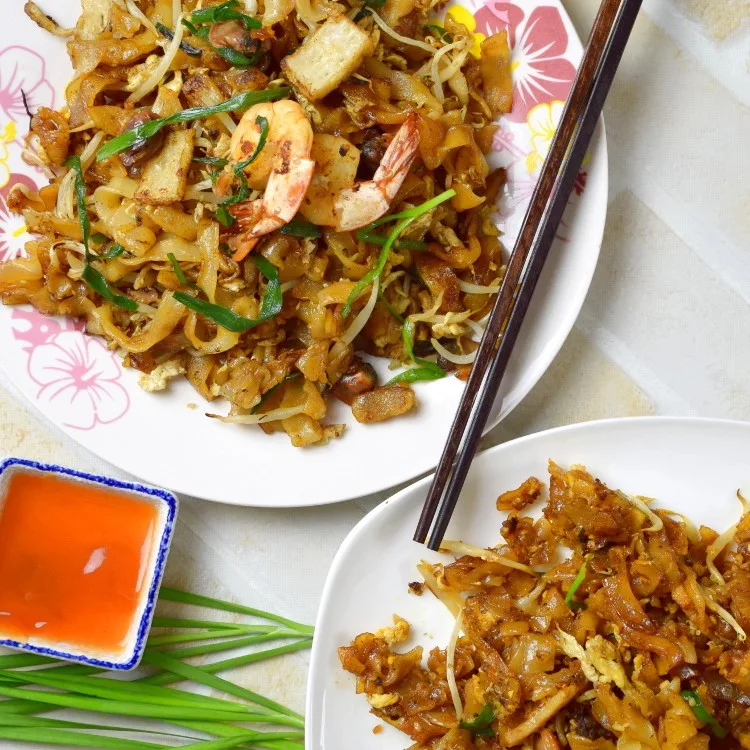
The word Char Kuey Teow is the phonetic approximation of the Chinese word 炒粿条 pronounced in Hokkien.
Therefore, Chow Kuey Teow, Char Koey Teow, Char Kway Teow, Keuy Teow Goreng, Char Keow Teow are all the acceptable translation, which means the same thing.
Note: This post may contain affiliate links. Please read my private policy for more info. I may receive commissions for purchases made through links in this post.
What is Char Kuey Teow exactly
Char Kuey Teow is best described as flat rice noodles stir-frying over intense heat in a well-seasoned wok with cockles, Chinese sausage, bean sprouts, and fish cake.
The stir-frying takes only a few minutes, with just simple ingredients. The X factor that makes it so addictive is the distinctive wok flavor created by the masterfully stir-frying technique.
Char Kuey Teow is similar to the Thai fried noodles Pad See Ew. You can get this recipe which I posted not long ago.
How to cook Char Kuey Teow
In short, this is how to cook it:
- Add the ingredients to the wok in this order- oil, prawns, garlic, noodles, bean sprouts, seasoning, egg, Chinese chives and blood cockles.
- Stir-fry over high heat.
However, these simplified steps will not guarantee for getting a plate of Char Kuey Teow measured up with the local hawkers. You probably need many rounds of trials plus a bit of luck.
So I will soothe your disappointment for not having a plate of Siam Road Char Kuey Teow by painstakingly explain every step in detail.
Let’s get started.
The ingredients
The authentic Char Kuey Teow must be prepared with a few must-have ingredients- Chinese sausage, blood cockles, bean sprouts, egg, and Chinese chives.
Penang Char Kuey Teow is generally considered the best. Many restaurants and hawkers at other cities named their stir-frying noodles as Penang Char Kuey Teow to attract customers.
1. The noodles (call kuey teow)
There are two types of kuey teow available. The wider one is more suitable for stir-frying, and the narrower one is for soup noodles. If you happen to buy a piece of the uncut kuey teow, cut them into wide strips and loosen it so that they do stack up on each other.
Get the dry kuey teow only if you can’t get the fresh one. Follow the instruction to rehydrate the dry kuey teow before frying.

2. Blood cockles
These cockles are the signature ingredients of Char Kuey Teow. However, not everyone likes to eat cockles. It is widely available in Malaysia but can be difficult to get outside South-East Asia. Furthermore, some people are put off by the English name (bloody!) and prefer to omit it.
Follow these step to clean and prepare the cockles:
1. Rinse the cockles with water.
2. Remove the cockles and place them in another container. Add some water enough to cover them.
3. Add a teaspoon of salt to the water and wait for a few minutes. Change the water a few time until the water runs clear.
4. Open the shell by using a small knife or just by hand.
5. Keep refrigerated immediately.
Tip: Soak the cockles in hot water for half a minute if you have difficulty to open the shell. Hot water helps to loosen the shelf so that you can remove the flesh easily.
3. Lard and the cracklings
The second common ingredient is lard crackling. It is made by rendering the pork fat by heating it up in the wok. The cracklings are aromatic and crispy while it is freshly made. Bear in mind that lard is saturated fat, and has a reputation as unhealthy food.
The authentic Char Kuey Teow stir-fried by the Chinese hawker ‘sifu’ has an unmistakable aroma of lard. The non-greasy lard crackling oozing out its unique flavor to tantalize your taste buds. Again, you will not see these ingredients in my recipe due to health reason.
I use vegetable oil to fry the kuey teow, which means the creation of wok flavor and the contrasting texture of each ingredient carry a more significant role to the overall standard of the dish.
4. Bean sprouts
The third most important ingredient is bean sprouts. The crunchiness of bean sprouts gives a sharp contrast to the chewy kuey teow.
If you were ever watching how the best Char Kuey Teow hawkers stir-fry the noodles, you would know that the heat of the stove is intense. They use a medium to high heat for the entice coking process without having any issues of wok-sticking. This is achieved by using a well-seasoned wok. A non-stick pan is not suitable to prepare Char Kuey Teow as it cannot withstand high heat.
Add the bean sprouts gradually as it helps to prevent the noodles from clumping together. However once the bean sprout is wilt, it will lose its crunchiness. Therefore, I prefer to reserve part of the bean sprouts and add in the last few seconds, have a few quick stirs, flip, and dish up. You can really feel the freshness and crunchiness of the bean sprouts in between bites of the kuey teow with a smoky flavor. This contrast of texture and flavor is the mouth-feel that street food lovers are looking for.
5. Chinese sausage
Chinese sausage is the typical ingredients for a traditional plate of Char Kuey Teow. Place the Chinese sausage in hot water and blanch it for half a minute, drained. Remove the outer sheath of the sausage, and cut crosswise into thin slices. Throw in three or four slices of this sausage into the wok will enhance the flavor of the kuey teow.
6. Fishcake
This ingredient has become popular in preparing Char Kuey Teow, presumably to replace the Chinese sausage since many Malaysians do not eat pork.
Fishcake is made with minced fish meat and some salt. The mixture of minced fish meat and salt is mashed and smashed on the chopping board until springy. The meat is shaped to a rectangle and pan-fried on both sides.
It is too troublesome to make the fish cake just for preparing a plate of noodles. Even the professional Char Kuey Teow store owners are using the ready-made fish cake.
I use fish cake instead of Chinese sausage in this recipe.
7. Prawns
Put two medium size prawns to the wok before frying the kuey teow and pan-fry both sides slightly,
The hawkers will always prompt you to add prawns to the Char Kuey Teow and charge a higher price. It is undoubtedly tasty to have it, especially if you opt-out the blood cockles for whatever reasons.
8. Egg
A plate of Char Kuey Teow is not complete without egg. Push the kuey teow to the side of the wok, Crack an egg on the empty area and spread it thinly with the wok spatula. When the egg is still half-cooked, fold the kuey teow back on top of the egg. Stir and flip quickly so that the egg will adhere to the noodles.
9. Chinese chives
Chinese chives are added last. It cooks nearly immediately and will become tough if it is overcooked. Scallion is not the substitute as it has a different taste.
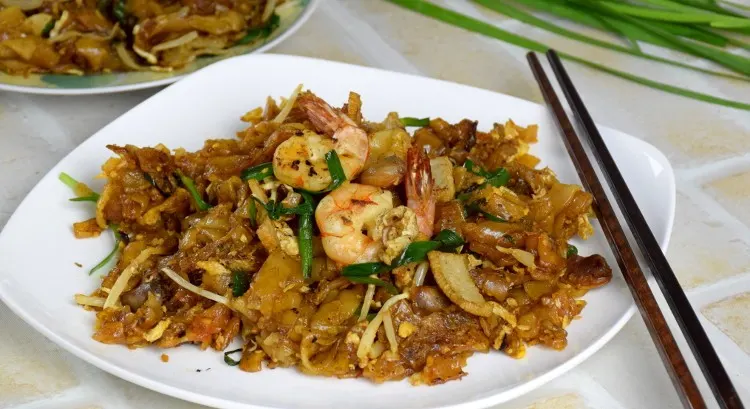
The Stir-frying process
Stir-frying is a quick and free-flowing process. Make sure you have all the ingredients within reach before you start. It will only take less than five minutes.
1. Cook the prawns
Ladle some oil into a well-seasoned wok. You can use lard to get the authentic Penang Char Kuey Teow aroma or use vegetable oil for a healthier version.
If you are the first-timer, use moderate to stir-fry so that there is more time to execute each step. Professional hawkers cook this dish like a stage performer, and everything flows smoothly without a glitch over high heat.
Once the oil is heated up, put two prawns into the wok. Let the prawns sear on one side and then flip over to pan-fry the other side.
2. Fry the kuey teow
Add some chopped garlic, once it becomes aromatic, throw in the loosen up kuey teow.
Kuey teow tends to stick if the wok is not seasoned. If you start to feel the Kuey Teow is about to stick, do either on or all of the following:-
1. Add part of the seasoning. The seasoning mixture moistens the Kuey Teow and preventing it from sticking.
2. Use more oil if it is insufficient.
3. Add a small number of bean sprouts to the Kuey Teow. The water release from the bean sprout will prevent the Kuey Teow from getting too dry.
4 Reduce the heat and keep stirring and flipping the Kuey Teow. Lower down the heat is the last resort as high temperature generates the signature wok aroma. The wok aroma and the slightly charred kuey teow is the standard that separates the best from the mediocre Char Kuey Teow.
The best solution to solve the sticking problem is to use a well-seasoned wok. If you watch the video below. You can notice that it is not sticky even over intense heat.
3. Add the Chinese sausage and fish cake.
You can add the fish cake slices at any time to the wok as it is pre-cooked. However, it is better to add the Chinese sausage earlier as it is raw.
4. Add the egg.
What is the best time to add the egg?
It is after the seasoning has thoroughly mixed with the noodles. The high heat should have caramelized the sauce and start to char the edges of the noodles.
You will start to smell the wok aroma permeates the whole kitchen. At this stage, there will be plenty of smoke rising up from the wok.
This is when you should turn down the heat and push the noodle to the side of the wok, leaving a clean area for adding the egg.
Reduce the heat to low-medium, Crack an egg and spread into a thin layer with the wok spatula. Add some oil if you think it will stick, it will not if you are using a well-seasoned wok.
When the egg becomes half-cook, scoop up the kuey teow and flip it onto the egg. Stir and flip quickly so that part of the egg will stick onto the Kuey Teow.
5. The bean sprouts
As I mentioned earlier, you can divide the bean sprouts into a few portions and add throughout the sit-frying process. We want to make use of the water release from the bean sprout to moisten the noodles a bit, but not too much that will bring down the temperature abruptly, The wok aroma (wok-hei) cannot be generated if the noodles are too wet.
Add the last portion of the bean sprouts along with the Chinese chives and have a quick stir-fry over high heat for 15 to 30 seconds to finish the cooking.!
6. Chinese chive
The Chinese chive has a unique flavor and aroma. It cannot be substituted with scallion as both have a different taste and smell. Chinese chive is widely used in Asian cuisine. The Japanese gyoza and the Chinese guotie are dumplings made with plenty of Chinese chives.
Chinese chives cook almost instantly. Add them to the wok along with the final portion of the bean sprouts.
7. The blood cockles
This is the must-have ingredients of the authentic Penang Char Kuey Teow. Unfortunately, there are a few reasons people (especially from abroad) may want to omit this in the recipe.
1. Some people may not feel comfortable with the English name ‘blood cockles.’
2. It is best to eat it semi-raw, which again is another reason why some people are hesitating to use it.
3. It is difficult to get outside South-East Asia, as it is not a regular delicacy elsewhere.
If you like it, add it to the wok at the final seconds and bury underneath the noodles. Turn off the heat. The heat of the kuey teow is sufficient to cook them.
8. The seasoning
We use a simple combination of light soy sauce, dark soy sauce, fish sauce (optional), oyster sauce and ground white pepper to season the noodles. Take note of the following points:
1. Use Chinese soy sauce. Chinese, Japanese, Indonesian and Thai soy sauce have a different flavor.
2. The saltiness varies from one brand to another. Therefore, please adjust the level of saltiness as stated in the recipe.
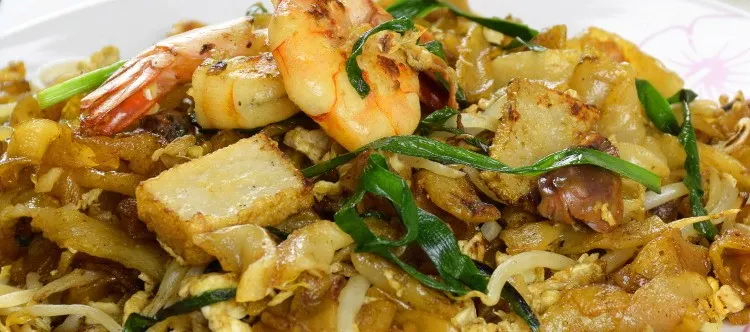
Bonus tips:
Char the noodles
You can spread the noodles thinly on the wok to pan-fried until they are slight char over medium heat. Flip over and pan-fry the other side. This method is very useful to create the wok aroma mainly if you do not have a stove that can generate high heat throughout the stir-frying process.
Add the seasoning in stages
There will be no wok aroma generated if the kuey teow is wet. Therefore, add the seasoning bit by bit throughout the whole process. The noodles are cannot get char if you add all the seasoning at the initial stir frying stage unless you are using a high power wok stove.
The Char Kuey Teow Recipe
The Penang Char Kuey Teow recipe

Siam Road Char Kuey Teow of Penang was ranked 14th on the Wold Street Food Top 50 list at the World Street Food Congress 2017 in Manila held from May 31 to June 4.
Ingredients
Ingredients:
- 200 g fresh Kuey Teow
- 3 tbsp vegetable oil for stir-frying
- 2 prawns, medium size, deveined and shelved, leave the tail on
- 4 slices Chinese sausage
- 10 slices fish cake
- 1 egg
- 1 cup bean sprouts
- 20 g Chinese chives , cut lengthwise to 5cm
- 10 blood cockles
Seasonings
Instructions
- Ladle some oil into a well-seasoned wok. Once the oil is heated up, put two prawns into the wok. Let the prawn sear on one side and then flip over to pan-fry the other side.
- Once the prawns turn slightly brown, add some chopped garlic, once it becomes aromatic, throw in the loosen up kuey teow.
- Add part of the seasoning.
- Add a small number of bean sprouts to the Kuey Teow. The water from the bean sprout will prevent the Kuey Teow from getting too dry.
- Add the Chinese sausage and fish cake.
- Add the remaining seasoning.
- Reduce the heat to low-medium, Crack an egg and spread into a thin layer with the wok spatula. When the egg becomes half-cook, lift up the kuey teow and flip it onto the egg. Stir and flip quickly so that part of the egg will stick onto the Kuey Teow.
- Add the last portion of the bean sprouts along with the Chinese chives and blood cockles. Have a quick stir-fry over high heat for 15 to 30 seconds to finish the cooking.!
Notes
Please refer to the text in the article for the details of each step.
Recommended Products
As an Amazon Associate and member of other affiliate programs, I earn from qualifying purchases.
Nutrition Information:
Yield:
1Serving Size:
1 plateAmount Per Serving: Calories: 3089Total Fat: 220gSaturated Fat: 49gTrans Fat: 3gUnsaturated Fat: 151gCholesterol: 1046mgSodium: 7134mgCarbohydrates: 103gFiber: 10gSugar: 12gProtein: 172g
This data was provided and calculated by Nutritionix on 6/18/2019
The ‘Feel-Good’ feeling of eating Char Kuey Teow at the roadside
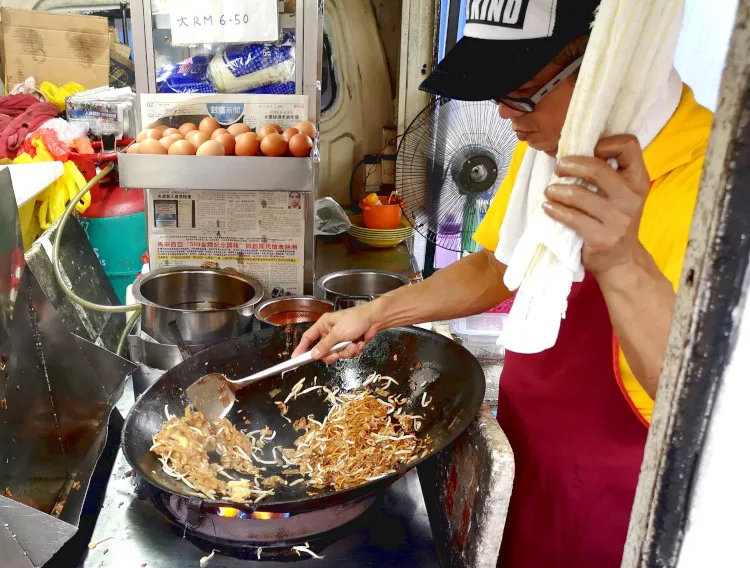
- Char Kuey Teow and other street food store are still available in Malaysia, but what will be their future? Slowly, but surely, they are moving into the Food Court located in the shopping malls and complexes.
- This hawker is selling Char Kuey Teow at the pasar malam (night market) which move from one residential area to another daily. He has a large number of loyal customers who will patronage at his mobile store once a week. He will lose all his loyal customers once relocated into the shopping complex.
- The air-conditioned, modern, more hygienic and presumably more comfortable The flavor may preserve, but the certain atmospheric elements are lost.
- The decision making in choosing a place to eat is more than just taste. The ambiance, the people, the friendliness of the owner and sometimes the nostalgic feeling and the long-standing culture are all processing in our mind subconsciously.
- For now, visit Penang for the authentic Char Kuey Teow at the roadside, or follow this recipe to cook up a wok of noodles to kill your cravings.

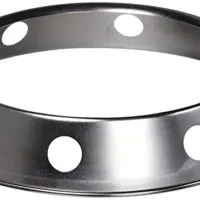
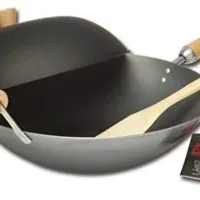
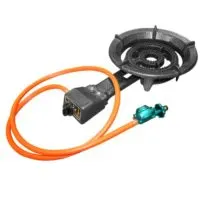
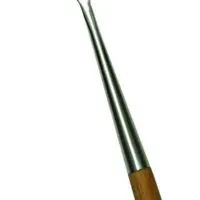
Molly
Wednesday 18th of May 2022
do we need to wash the kuetiaw first?
KP Kwan
Friday 20th of May 2022
There is no need to wash it before cooking.
Fred
Wednesday 27th of October 2021
Thanks for your recipe. The dark soy sauce is that the so-called thick cooking caramel?
KP Kwan
Thursday 28th of October 2021
Yes, that is what I am referring to.
Roger Loh
Monday 25th of May 2020
Very good and detailed recipe. And thanks for the tips and bonus tips as they help a lot in understanding why we add the seasong in stages, and when to add each ingredient. Thanks very much and keep up the good work!
KP Kwan
Monday 25th of May 2020
Hi Roger, Thanks for trying out the recipe. Surely I will keep uploading more recipes in the future. KP Kwan
toniXe
Thursday 13th of September 2018
Very complete information on this dish ! Tq. I must add that the best ckt shud use the freshest ingredients & enjoyed within 15 minutes after leaving the wok
KP Kwan
Friday 27th of July 2018
Hi, this is KP Kwan. I am happy to see you in this comment area, as you have read through my recipe. I am glad to reply to any questions and comments as soon as possible.